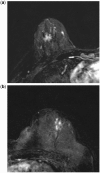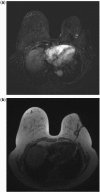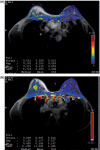Breast MR with special focus on DW-MRI and DCE-MRI
- PMID: 21771711
- PMCID: PMC3205756
- DOI: 10.1102/1470-7330.2011.0014
Breast MR with special focus on DW-MRI and DCE-MRI
Abstract
The use of magnetic resonance imaging (MRI) for the assessment of breast lesions was first described in the 1970s; however, its wide application in clinical routine is relatively recent. The basic principles for diagnosis of a breast lesion rely on the evaluation of signal intensity in T2-weighted sequences, on morphologic assessment and on the evaluation of contrast enhancement behaviour. The quantification of dynamic contrast behaviour by dynamic contrast-enhanced (DCE) MRI and evaluation of the diffusivity of water molecules by means of diffusion-weighted MRI (DW-MRI) have shown promise in the work-up of breast lesions. Therefore, breast MRI has gained a role for all indications that could benefit from its high sensitivity, such as detection of multifocal lesions, detection of contralateral carcinoma and in patients with familial disposition. Breast MRI has been shown to have a role in monitoring of neoadjuvant chemotherapy, for the evaluation of therapeutic results during the course of therapy. Breast MRI can improve the determination of the remaining tumour size at the end of therapy in patients with a minor response. DCE-MRI and DW-MRI have shown potential for improving the early assessment of tumour response to therapy and the assessment of residual tumour after the end of therapy. Breast MRI is important in the postoperative work-up of breast cancers. High sensitivity and specificity have been reported for the diagnosis of recurrence; however, pitfalls such as liponecrosis and changes after radiation therapy have to be carefully considered.
Figures














References
-
- BI-RADS® Atlas. American College of Radiology. http://www.acr.org/SecondaryMainMenuCategories/quality_safety/BIRADSAtla.... Accessed 20th February 2011.
-
- Sardanelli F, Fausto A, Menicagli L, Esseridou A. Breast vascular mapping obtained with contrast-enhanced MR imaging: implications for cancer diagnosis, treatment, and risk stratification. Eur Radiol. 2007;17(Suppl 6):F48–51. - PubMed
Publication types
MeSH terms
Substances
LinkOut - more resources
Full Text Sources
Medical
